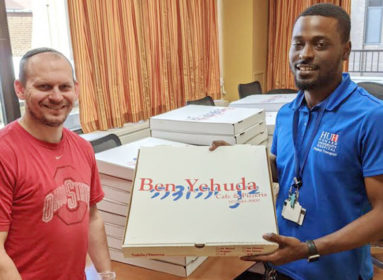
By Cindy Mindell
When addressing long-term needs of the Jewish community, many programmatic responses are geared toward younger populations. Initiatives like Taglit-Birthright, PJ Library, Moving Traditions, and the Foundation for Jewish Camp seek to engage kids and young adults in order to reverse the widely lamented post-b’nai mitzvah exodus.
To aid in the policy-making and programming that hopes to ensure Jewish continuity, Jewish communal professionals often turn to surveys that measure the beliefs, needs, and behaviors of younger Jewish cohorts.
But what about the other end of the demographic spectrum? The question of how to engage or re-engage Jewish Baby Boomers in Jewish life inspired the 2011 founding of the New York-based B3/The Jewish Boomer Platform, led by consultants David Elcott, PhD and Stuart Himmelfarb. Since then, the two have worked to change the conversation about aging in the Jewish community and explored the implications that this conversation has for the sustainability of the community.
Their just-released report, Generations & Re-Generation: Engagement and Fidelity in 21st Century American Jewish Life, published by the Research Center for Leadership in Action at NYU’s Wagner School, looks at the differences and similarities among the four cohorts of Jewish adults: Millennials, Gen X-ers, Baby Boomers, and the World War II or “Greatest Generation.” As Elcott and Himmelfarb studied the resulting data, they encountered additional issues and insights that shed light on the current challenges facing the Jewish community in terms of its near- and longer-term sustainability as a minority community in America.
More than 50 Jewish organizations across the country participated in the project, reflecting a broad inventory of regions, denominational affiliations, and metropolitan sizes. Each organization was asked to forward a link to the online survey to its email list. Through more than 12,500 questionnaires, the survey explored the demographics, beliefs, activities, and behaviors of those who have some degree of affiliation or connection with a Jewish institution as members, donors, and/or email subscribers.
In Connecticut, constituents of the Jewish Federation of Greater New Haven and of United Jewish Federation of Greater Stamford, New Canaan and Darien (UJF) answered the questionnaire. Jewish Federation of Greater Hartford leadership consulted with Elcott on the survey’s findings. All three will use the data to design programs to engage the adult cohorts in their respective catchment areas.
The study complements Elcott’s 2009 survey, Baby Boomers, Public Service and Minority Communities: A Case Study of the Jewish Community in the United States, the first national survey and analysis of Jewish Boomers and encore careers.
Elcott, a close personal friend of Jewish Federation of Greater New Haven CEO Sydney Perry, headed up the Jewish Federation of Greater New Haven community leadership program for several years. In his professional work and research, he warned that, as Baby Boomers reached retirement, their skills and resources might be lost if synagogues and Jewish communal organizations failed to develop engaging ways to retain their interest and channel their talents.
“Sometimes people with new ideas and new ways to operate within the Jewish community are not always recognized with alacrity,” says Perry, referring to Elcott’s 2009 study. “We were blind; we couldn’t imagine this group would ever leave our warm embrace. Now comes their next study, and lo and behold: it suggests that as the Jewish community faces some daunting challenges of hemorrhaging synagogue membership, apathy, and a diminishing engagement in institutional Jewish communal life, we are disregarding a treasure trove of talent and time in those born between 1946 and 1964. It is perilous to believe that this group, which belongs to, gives to, and participates in Jewish life at a higher rate than other generations, will always remain so committed. If we do not find new ways to connect with the Baby Boomers, we will lose not only their interest, but also the benefits they will provide for succeeding generations.”
The core question driving the study, and behind B3’s focus on Baby Boomers and intergenerational connections, is how to sustain a thriving American Jewish community, a focus that parallels an increased concern about the place and vitality of minority communities in 21st-century America.
Perry says that the Jewish Federation of Greater New Haven has two volunteer efforts that attract this older population. The Jewish Coalition for Literacy places 170 reading partners in seven inner-city schools, and Food4Kids (a joint project of Women’s Philanthropy and Jewish Family Service) provides healthy food for children to take home on the weekends. The Jewish Federation is developing a workforce-mentoring partnership between its Baby Boomer volunteers and Gateway Community College in New Haven. Perry says that she and fellow Federation leaders are planning continuing education programming for this older population, as well as intergenerational volunteer opportunities in the Jewish and greater communities.
“As a member of the Baby Boomer generation, I am hopeful that we can create meaningful opportunities for this age group,” she says. “We just have to harness the enormous creativity and energy of our largest population group. And we need to do it in short order. The future is in our hands.”
Among the survey’s key findings and recommendations:
• Personal change and communal engagement potential are not limited to the young. Although many funders and organizations focus large shares of their efforts on one cohort – “Next Gen” Millennials, for example – the study finds that significant numbers of connected Jews of all ages experience their Jewish lives and affiliations as evolving over time. Organizations may reap significant benefits from expanding their engagement efforts to include older age cohorts, and, correspondingly, if communal institutions maintain a focus almost exclusively on the young, they should not expect that all older Jews now connected to the community will necessarily remain so. In terms of policies and practices, this means that organizations should eliminate age as a criterion in programs, including the kinds of learning and leadership training programs usually offered to “young leaders.”
• “Damning with faint praise:” Although highly connected to Jewish communal institutions, this population is only tepidly satisfied with them. Among the three post-war generations, well under 20 percent are “very satisfied” with JCCs and Jewish Federations, and only one-third or less of each cohort expresses great satisfaction with synagogue life.
• Belonging to the Jewish people is very important to strong majorities of all four age cohorts, but its importance declines among younger respondents. Frequency of attending Jewish cultural events – museums, films, plays, concerts – also decreases for the younger generations. The decline in the importance of identity for the young extends to American identity as well.
• American Jews are without a compelling narrative to bind them. The Holocaust, while remaining the “lead story” for an overwhelming number of Jews, does not describe the experience of Jews in the U.S. This population expresses a clear pessimism about the future of Israel, America, and the world, a situation not helped by the organized Jewish community’s continual focus on anti-Semitism, Jewish suffering, and death. The powerful Zionist story with which many Jews grew up is waning as an effective unifying narrative.
• Engaged Jews are strongly identified both with universal values (making the world better for everyone) and with being Jewish (and addressing Jewish needs), but their levels of motivation and enthusiasm for universal values are significantly stronger and more consistent than their Jewish ones. This gap is especially apparent in responses to questions about motivations for volunteering. Universal values are more strongly and consistently affirmed than Jewish values as personal motivations to volunteer.
• Online media are important for reaching all age groups. Although social media are less prevalent among the very oldest of connected Jews, online Jewish content and social media are a part of the lives of strong majorities of all age groups.
• The ways in which many Jews describe themselves and how they feel about their Jewish lives and activities are changing. Traditional terms and statements are no longer relevant for many. For some, traditional denominational labels no longer apply, so appeals using that language might not attract their interest. For others, connections and participation in an activity might be possible, but should not be interpreted as interest in formal membership.
• Successful synagogues and other organizations will become platforms for engagement in which Jews can collaboratively choose activities and behaviors that they consider Jewish, highlighting volition and creative collaboration as opposed to top-down programmatic offerings by the professionals and their volunteer boards. This shift in the way the Jewish community organizes applies to the ways synagogues and other institutions organize their membership fees: the more rigid and fixed their structure, the less likely they are to fit people’s needs or expectations. In a landscape in which personalization and customization are routine, a system that does not offer flexibility will be less attractive.
To read the full study: wagner.nyu.edu/files/faculty/publications/GenerationAndReGeneration_September2014.pdf








 Southern New England Jewish Ledger
Southern New England Jewish Ledger










